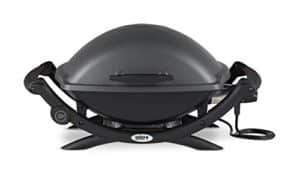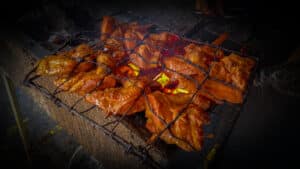How To Use A Charcoal Grill As A Smoker?
Key Takeaways
- Using a charcoal grill as a smoker is possible with a few simple steps and basic equipment
- Setting up the charcoal grill properly is the first step, including creating a two-zone grilling setup with direct and indirect heat
- Controlling the temperature, using drip pans and water pans, and slow cooking the meat are important steps in smoking meat on a charcoal grill
If you have a charcoal grill and want to venture into the world of smoking, you’re in luck! With a few simple steps and some basic equipment, you can transform your charcoal grill into a smoker and enjoy the delicious flavors of smoked meats. In this article, we will guide you through the process of using a charcoal grill as a smoker, providing you with all the information you need to get started.
Step 1: Set Up Your Charcoal Grill
The first step in using a charcoal grill as a smoker is to set it up properly. Start by using charcoal as your fuel source. You can either light the coals using a chimney starter, which is a quick and efficient method, or by directly lighting the coals. It’s important to avoid using lighter fluid, as it can add unwanted flavors to your smoked meat.
Once your coals are lit, place them in one side of the grill. This will create a two-zone grilling setup, with one side for direct heat and the other side for indirect heat. The indirect heat side will be used for smoking the meat.
Step 2: Control the Temperature
Temperature control is crucial when smoking meat. To regulate the temperature of your charcoal grill, you will need to control the grill’s dampers. The intake damper, located at the bottom of the grill chamber, and the exhaust damper, located at the top, control the amount of air coming in and out of the grill.
To maintain a steady temperature of around 225°F, partially open both dampers. This will allow for a consistent flow of air and will help regulate the heat inside the grill. It’s important to monitor the temperature using a grill surface thermometer to ensure it stays within the desired range.
Step 3: Use a Drip Pan and Water Pan
To enhance the smoking process and prevent the meat from drying out, it’s recommended to use a drip pan and a water pan. The drip pan will collect any run-off from the meat, while the water pan will provide moisture and help maintain a humid environment inside the grill.
Place the drip pan directly underneath the meat to catch any drippings. The water pan should be placed on the indirect heat side of the grill, opposite the coals. Fill the water pan with water to create steam and add moisture to the cooking process. This will help keep the meat tender and juicy.
Step 4: Set Up for Two-Zone Grilling
Two-zone grilling is a technique that allows you to have both direct and indirect heat on your charcoal grill. This setup is perfect for smoking meat, as it provides a controlled environment for slow and even cooking.
To set up for two-zone grilling, visually divide the grill chamber into two halves. Ignite the coals on one side and stack them to create a constant but not high heat. This will be your direct heat zone. Place the water and drip pans on the other side, which will be your indirect heat zone.
Step 5: Start Smoking Your Meat
Now that your charcoal grill is set up and the temperature is under control, it’s time to start smoking your meat. Place the cooking grates back into place and ensure that the meat is positioned in the no-heat zone over the drip tray.
Cook the meat using the “low and slow” method, which means cooking it for a long time at a low temperature. This slow cooking process allows the flavors to develop and the meat to become tender. It’s important to monitor the temperature throughout the smoking process and adjust the dampers as needed to maintain a steady temperature.
Consider using an automatic temperature controller to help regulate the internal temperature of the grill. This device can monitor and adjust the temperature automatically, saving you the hassle of constantly monitoring the grill.
Step 6: Enjoy the Fruits of Your Labor
After patiently smoking your meat for the desired time, it’s time to enjoy the delicious flavors of your efforts. Remove the meat from the grill and let it rest for a few minutes before serving. This allows the juices to redistribute and ensures a moist and flavorful result.
Whether you’re smoking ribs, brisket, chicken, or any other type of meat, using a charcoal grill as a smoker can yield fantastic results. With practice and experimentation, you’ll be able to master the art of smoking on your charcoal grill and impress your family and friends with your smoky creations.
Related Websites:
- The Online Grill: How to Use a Charcoal Grill as a Smoker
- The Grilling Master: How to Smoke Ribs on a Charcoal Grill – A Step-by-Step Guide
- Better Grills: How to Smoke on a Charcoal Grill
- Carnivore Style: Pellet vs Charcoal Smoker
- Carnivore Style: Best Types of Smokers
- The Flat Top King: How to Use Your Charcoal Grill as a Smoker
FAQs:
Q: What are the benefits of using a charcoal grill for smoking?
Using a charcoal grill for smoking offers several benefits, including imparting a smoky flavor to the food, achieving a tender and juicy texture, and providing versatility for different types of smoking techniques.
Q: How do I set up a two-zone fire for smoking on a charcoal grill?
To set up a two-zone fire, arrange the charcoal on one side of the grill and leave the other side empty. This allows for indirect heat cooking, where the food is placed away from direct flame and cooked slowly using the heat circulating inside the grill.
Q: What types of wood are commonly used for smoking on a charcoal grill?
Common types of wood used for smoking on a charcoal grill include hickory, mesquite, apple, cherry, and oak. Each wood imparts a unique flavor to the food, allowing you to experiment and create different taste profiles.
Q: How can I maintain temperature control while smoking on a charcoal grill?
To maintain temperature control, adjust the airflow by partially opening or closing the vents on the grill. Opening the vents allows more oxygen, increasing the temperature, while closing them decreases the airflow, lowering the temperature. Monitoring the temperature with a thermometer is also important for precise cooking.
Q: How should I clean and maintain my charcoal grill after smoking?
After smoking, allow the grill to cool down. Remove any remaining ashes and clean the grates using a grill brush. Wipe down the interior and exterior surfaces with a damp cloth. Regular maintenance, such as checking for rust and storing the grill properly, will ensure its longevity.






